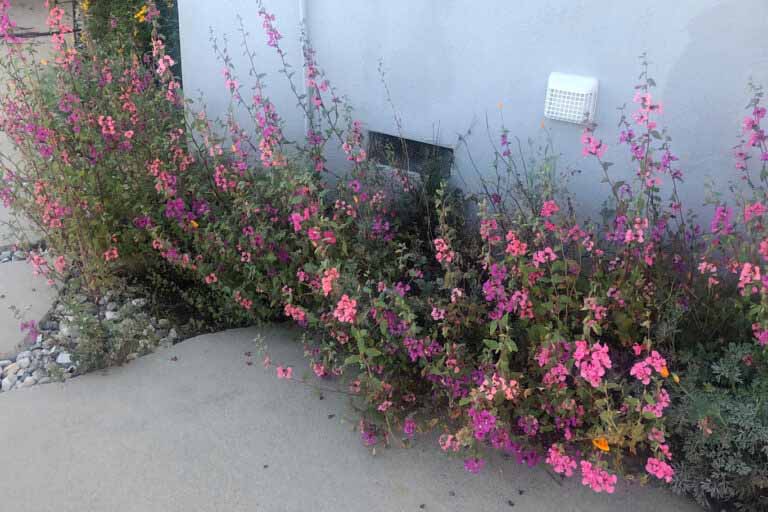Wildflowers
Whether for beauty, food for pollinators and songbirds, or to fill empty space, you may wish to integrate some areas of California native annual wildflowers into areas of your garden that are not already occupied by other plants.

A few small patches of wildflowers can add a lot to your garden while requiring very little work. However, large meadows of wildflowers do tend to require a lot of weeding, so it is best to start small when you are first experimenting with growing annual wildflowers.
Many different California native wildflowers grow easily in our home gardens. Here are some of the easiest and most beautiful to start with:
Sunny areas
- California poppy
- Desert bells
- Tansy leaf phacelia (larger areas)
- Clarkia (many species)
Part shade areas
- Clarkia (many species)
California native wildflower seed mixes

Many retailers of California native wildflowers also sell mixes of different wildflower seeds and can help you select which mixes might be best to try in your situation. Mixes can be a lot of fun, because even with the same seed mix, different spaces in your yard and the weather in different years can result in a different mix of flowers! In our area, local retailers include the Grow Native Nursery at the California Botanic Garden in Claremont, Theodore Payne Foundation in Sun Valley, Tree of Life Nursery in San Juan Capistrano, and Peaceful Valley Farm Supply (if ordering from Peaceful Valley, be sure you are ordering California native wildflower seeds or mixes as they sell seeds from many other areas as well).
When and how to plant wildflowers
California native wildflowers must be seeded into your garden in fall though early winter. Immediately before the first rains is usually a perfect time to do it.

To spread seed, lightly sprinkle your seeds into the desired area, being careful not to spread seeds too closely to small new plantings, because the wildflowers tend to grow very quickly and may shade small adjacent plants. Seed can be spread directly on open soil or on top of a mulched garden surface. Wildflowers will sprout up best on open soil or on lightly mulched gardens (1-2”).
You can either leave the seeds on the surface, or very lightly rake them into the soil or mulch, ideally settling them only 1/8”-1/4” or so into the soil. After seeding you can either just let the rain water them, or, for more control or to guarantee good growth, you can water occasionally, usually no more than once per week when the weather is dry, until they get established. “Established” means they have grown significantly.
Wildflowers during & after bloom



Wildflowers will grow though the fall and winter, then bloom in the spring. If desired, blooms can be extended with an occasional irrigation in the spring. After blooms fade, allow seeds to ripen to feed seed-eating birds. If you live in an urban wildland interface area and wildfire is a concern, remove spent wildflowers before they dry. If you live in an urban area without this concern, you may choose to allow plants to dry out and drop seed naturally. Some will be eaten by birds, and some will usually regrow the following season. After that you may either chop up plants to add to the mulch layer, compost them if you do not mind wildflower seeds in your compost, or place them in your green bin.